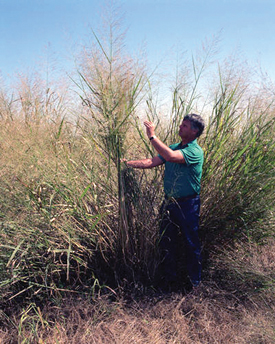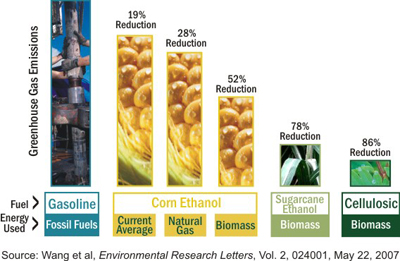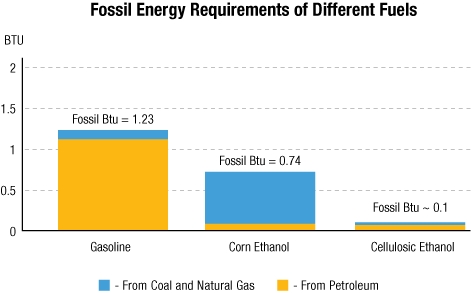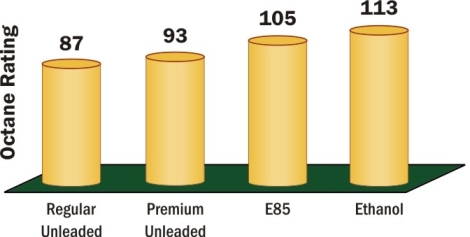U.S. Department of Energy - Energy Efficiency and Renewable Energy
Bioenergy Technologies Office
Ethanol Myths and Facts
|
The U.S. Department of Energy (DOE) is committed to
advancing technological solutions to promote and increase the use of
clean, abundant, affordable, and domestically- and sustainably-produced
biofuels to diversify our nation's energy sources, reduce greenhouse gas
emissions, and reduce our dependence on oil.
U.S. energy consumption is expected to grow over 18
percent by 2030. Biofuels must continue to play a significant role as we
work aggressively to diversify our nation's energy sources and provide a
balanced portfolio of energy solutions to help meet our growing demand
for energy.
Since 2007, DOE has announced over $1 billion in
multi-year biofuels research and development projects. Integral to this
work is the ongoing examination of reducing greenhouse gases as well as
land and water use.
The U.S. Department of Energy is carrying out a
comprehensive plan to increase energy efficiency as well as the use of
renewable fuels in the transportation sector. This includes basic and
applied research and development projects with a broad range of
technology demonstrations to help rapidly bring online next-generation
biofuels.
|

Future biofuels will be made from a wide range of
hardy and fast-growing plants, such as switchgrass--which is a perennial
native to American prairies. Switchgrass requires about a quarter of
the irrigation and fertilization of row crops.
Ethanol is a clean, renewable fuel. It is helping to reduce our
nation's dependence on oil and offers a variety of economic and
environmental benefits. As we look to broaden our domestic energy
resources, common misconceptions about ethanol production and use need
to be cleared up. This page addresses some of the common myths about
ethanol.
More information can also be found on this site's Frequently Asked Questions page.
MYTH: In terms of emissions, ethanol pollutes the same as gasoline or more.
FACT: Ethanol results in fewer greenhouse gas (GHG) emissions than
gasoline and is fully biodegradable, unlike some fuel additives.
-
Today, on a life cycle basis, ethanol produced from corn results
in about a 20 percent reduction in GHG emissions relative to
gasoline. With improved efficiency and use of renewable energy, this
reduction could be as much as 52 percent.
-
In the future, ethanol produced from cellulose has the potential
to cut life cycle GHG emissions by up to 86 percent relative to
gasoline.
-
Ethanol blended fuels currently in the market – whether E10 or E85 – meet stringent tailpipe emission standards.
-
Ethanol readily biodegrades without harm to the environment, and
is a safe, high-performance replacement for fuel additives such as MTBE.

In comparison to gasoline, ethanol made from
cellulose and produced with power generated from biomass byproducts can
result in an 86 percent reduction in greenhouse gas emissions.
MYTH: Ethanol cannot be produced from corn in large enough
quantities to make a real difference without disrupting food and feed
supplies.
FACT: Corn is only one source of ethanol. As we develop new,
cost-effective methods for producing biofuels, a significant amount of
ethanol will be made from more abundant cellulosic biomass sources.
-
Future ethanol will be produced increasingly from cellulose found
in crop residues (e.g., stalks, hulls), forestry residues (e.g., forest
thinning, wood byproducts), energy crops (e.g., switchgrass, sorghum),
and sorted municipal wastes. Some promising energy crops grow on
marginal soils not suited for traditional agriculture.
-
A high-protein animal feed, known as Distiller's Dried
Grains with Solubles (DDGS), is produced in the process of making
ethanol from corn.
-
The Energy Independence and Security Act of 2007 (EISA)
requires use of 36 billion gallons of renewable transportation fuels in
the U.S. by 2022. Of that quantity, 16 billion gallons must
be cellulosic biofuels. Ethanol from corn is capped at 15 billion
gallons.
-
The U.S. Departments of Energy and Agriculture's Billion-Ton Study found
that we can grow adequate biomass feedstocks to displace approximately
30 percent of current gasoline consumption by 2030 on a sustainable
basis – with only modest changes in land use. It determined that 1.3
billion tons of U.S. biomass feedstock is potentially available for the
production of biofuels – more than enough biomass to meet the new
renewable fuel standard mandated by EISA.
MYTH: More energy goes into producing ethanol than it delivers as a fuel.
FACT: In terms of fossil energy, each gallon of ethanol produced
from corn today delivers one third or more energy than is used to
produce it.
-
Ethanol has a positive energy balance – that is, the energy content of ethanol is greater than the fossil energy used to produce it – and this balance is constantly improving with new technologies.
-
Over the last 20 years, the amount of energy needed to produce
ethanol from corn has significantly decreased because of improved
farming techniques, more efficient use of fertilizers and pesticides,
higher-yielding crops, and more energy-efficient conversion technology.
- Most studies that claim a negative energy balance for ethanol
fail to take into account the energy contained in the co-products.

This graph shows how much fossil energy is required
to provide 1 BTU of each fuel at the pump. The graph does not reflect
energy derived from solar or other renewable sources used in the
production of ethanol.
MYTH: Ethanol-gasoline blends can lower fuel economy and may harm your engine.
FACT: Ethanol blends in use today have little impact on fuel economy or vehicle performance.
-
While ethanol delivers less energy than gasoline on a
gallon-for-gallon basis, today's vehicles are designed to run on
gasoline blended with small amounts of ethanol (10 percent or less)
with no perceptible effect on fuel economy.
-
Flex-fuel vehicles designed to run on higher ethanol blends
(E85 or 85 percent ethanol) do experience reduced miles per
gallon, but show a significant gain in horsepower.
- As a high-octane fuel additive and substitute for MTBE, ethanol
enhances engine performance and adds oxygen to meet requirements for
reformulated gasoline.

Race cars of the Indy Racing League benefit from the high performance characteristics of ethanol.
MYTH: Rainforests will be destroyed to create the new
croplands required to meet food, feed, and biofuels needs, thus
accelerating climate change and destroying valuable ecosystems.
FACT: Biofuels have the potential to significantly reduce global GHG
emissions associated with transportation, but—as with all types of
development—controls are needed to protect ecologically important lands.
-
In Brazil and elsewhere, laws have already slowed deforestation,
and for the past decade China has converted marginal croplands to
grassland and forests to control erosion.
-
Links between U.S. ethanol production and land use changes
elsewhere are uncertain. We cannot simply assume that increases in U.S.
ethanol production will lead to increased crop production abroad.
Since 2002, during the greatest period of ethanol growth, U.S. corn
exports increased by 60 percent and exports of Distiller's Dried Grains
(DDGs) also increased steadily. In part, improvements in U.S. corn
yield (about 1.6 percent annually since 1980) have enabled
simultaneous growth in corn and ethanol production.
- Greenhouse gas emissions will decrease dramatically
as biofuels of the future are increasingly made
from cellulosic feedstocks and as the associated farming,
harvesting, transport, and production processes increasingly use clean,
renewable energy sources.
Further Reading
For more information about the energy balance, environmental impacts,
and overall value of ethanol as a fuel, see the following sites. Some
files may require Adobe Acrobat Reader. Download Adobe Reader.
Energy Balance
Environmental Impacts
Value
Feedstock Availability
|



